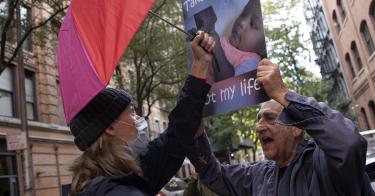On March 30, 2022, the Justice Department announced the indictment of nine individuals for violating the Freedom of Access to Clinic Entrances Act (FACE). This law makes it a crime to, “by force or threat of force,” physically obstruct, intentionally injure, intimidate, or interfere with any person to prevent them from “obtaining or providing reproductive health services.”
Now a federal judge is using this case to promote her own abortion-rights agenda.
Three months after the indictment, the Supreme Court overruled its decisions inventing a constitutional right to abortion, holding that “the Constitution does not confer a right to abortion.” Lauren Handy, the lead defendant in the FACE Act case, moved to dismiss the indictment against her, arguing that this statement from Dobbs eliminated the U.S. District Court’s jurisdiction over the case.
This should have been an easy call for Judge Colleen Kollar-Kotelly. The constitutional status of abortion has nothing at all to do with a court’s jurisdiction over FACE Act cases. In fact, Kollar-Kotelly’s own appeals court has held that the FACE Act was an exercise of Congress’s power to regulate interstate commerce. She should have, therefore, simply denied Hardy’s motion to dismiss.
Instead, pace Rahm Emanuel’s famous counsel not to “let a serious crisis go to waste,” Kollar-Kotelly was not about to let a poor legal argument go to waste when it can serve a political agenda. In three steps, she pivoted from an easily denied motion to dismiss a criminal indictment into her own attempt to find a new constitutional basis for abortion rights.
First, rather than deny the motion, Kollar-Kotelly treated the Supreme Court’s statement in Dobbs that “the Constitution does not confer a right to abortion” as not only relevant to Hardy’s motion to dismiss, but one requiring “additional briefing.”
Second, this additional briefing would not address the FACE Act or Handy’s indictment, that is, the case actually before the court. Instead, Kollar-Kotelly wanted to explore whether the Supreme Court in Dobbs meant “the Constitution” when it said “the Constitution.”
The issue in Dobbs, she wrote, “was not whether any provision of the Constitution provided a right to abortion…[but] whether the Fourteenth Amendment to the Constitution provided such a right.” It is “entirely possible,” she speculated, “that the Court might have held in Dobbs that some other provision of the Constitution provided a right to access reproductive services had that issue been raised. However, it was not raised.”
This is the judicial version of the criminal-defense lawyer’s strategy known as SODDI—some other dude did it. Kollar-Kotelly is trying to suggest that, even after Dobbs, a constitutional right to abortion still exists, but that “some other provision did it.” And she seems determined to find the constitutional culprit, enlisting the parties in the Handy case as her investigators. Like a professor assigning a term-paper topic, Kollar-Kotelly ordered the parties to brief two issues: “(1) whether the scope of Dobbs is in fact confined to the Fourteenth Amendment and (2) whether, if so, any other provision of the Constitution could confer a right to abortion as an original matter . . . such that Dobbs may or may not be the final pronouncement on the issue, leaving an open question.”
>>> A Judge Turns Abortion Advocate, Part Two
As noted, the constitutional status of abortion in general, and the Supreme Court’s Dobbs statement in particular, have nothing to do with whether Kollar-Kotelly had jurisdiction over Handy’s FACE Act prosecution. Kollar-Kotelly not only inappropriately claimed a connection where none exists, but actually claimed that jumping into the dumpster of constitutional speculation was somehow necessary “to ensure the correct and just disposition of this criminal action.”
Third, Kollar-Kotelly not only ordered the parties to address whether “any other provision of the Constitution could confer a right to abortion,” but told them where to start. “Of those provisions that might contain some right to access [abortion] services,” she wrote, “the Thirteenth Amendment has received substantial attention.” As she likely intended, this triggered all manner of chatter about how Dobbs might not have meant what it said and whether a right to abortion might still be lurking somewhere in the Constitution.
None of this was appropriate. Kollar-Kotelly should remember which side of the bench she occupies.
This piece originally appeared in The National Review




